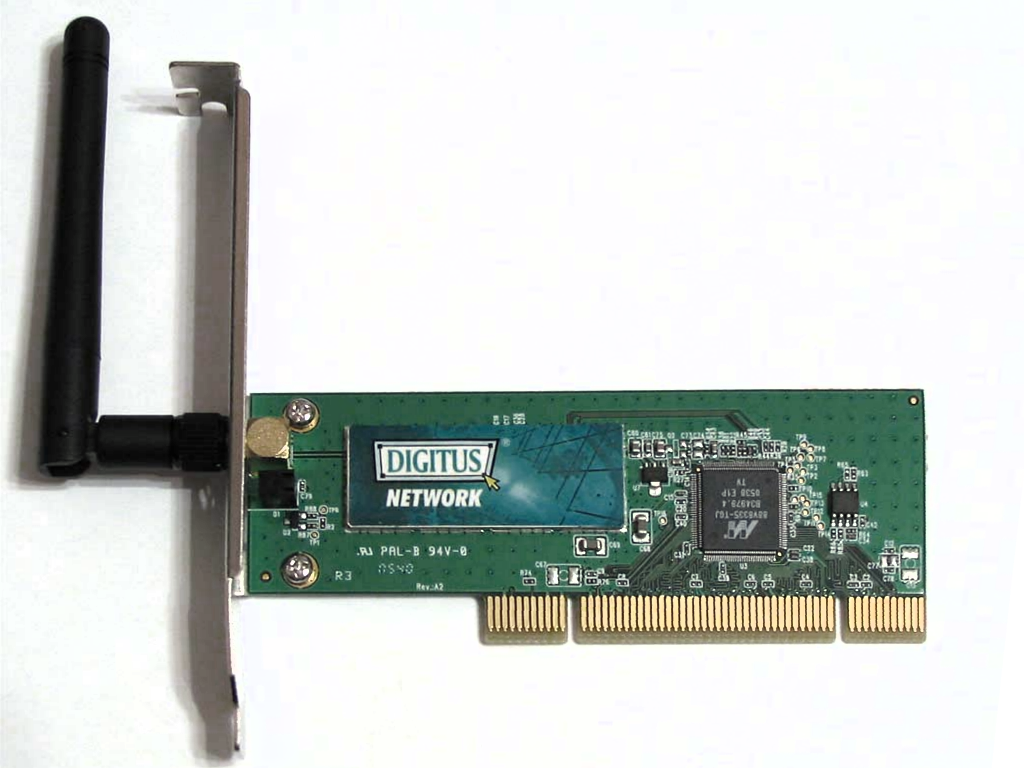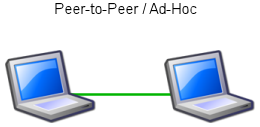|
Point Coordination Function
Point Coordination Function (PCF) is a media access control (MAC) technique used in IEEE 802.11 based WLANs, including Wi-Fi. It resides in a point coordinator also known as access point (AP), to coordinate the communication within the network. The AP waits for PIFS duration rather than DIFS duration to grasp the channel. PIFS is less than DIFS duration and hence the point coordinator always has the priority to access the channel. The PCF is located directly above the distributed coordination function (DCF), in the IEEE 802.11 MAC Architecture. Channel access in PCF mode is centralized and hence the point coordinator sends CF-Poll frame to the PCF capable station to permit it to transmit a frame. In case the polled station does not have any frames to send, then it must transmit null frame. Due to the priority of PCF over DCF, stations that only use DCF might not gain access to the medium. To prevent this, a repetition interval has been designed to cover both (Contention free) ... [...More Info...] [...Related Items...] OR: [Wikipedia] [Google] [Baidu] |
|
|
Media Access Control
In IEEE 802 LAN/MAN standards, the medium access control (MAC), also called media access control, is the layer that controls the hardware responsible for interaction with the wired (electrical or optical) or wireless transmission medium. The MAC sublayer and the logical link control (LLC) sublayer together make up the data link layer. The LLC provides flow control and multiplexing for the logical link (i.e. EtherType, 802.1Q VLAN tag etc), while the MAC provides flow control and multiplexing for the transmission medium. These two sublayers together correspond to layer 2 of the OSI model. For compatibility reasons, LLC is optional for implementations of IEEE 802.3 (the frames are then "raw"), but compulsory for implementations of other IEEE 802 physical layer standards. Within the hierarchy of the OSI model and IEEE 802 standards, the MAC sublayer provides a control abstraction of the physical layer such that the complexities of physical link control are invisible to ... [...More Info...] [...Related Items...] OR: [Wikipedia] [Google] [Baidu] |
|
 |
Wireless LAN
A wireless LAN (WLAN) is a wireless computer network that links two or more devices using wireless communication to form a local area network (LAN) within a limited area such as a home, school, computer laboratory, campus, or office building. This gives users the ability to move around within the area and remain connected to the network. Through a gateway, a WLAN can also provide a connection to the wider Internet. Wireless LANs based on the IEEE 802.11 standards are the most widely used computer networks in the world. These are commonly called Wi-Fi, which is a trademark belonging to the Wi-Fi Alliance. They are used for home and small office networks that link together laptop computers, printers, smartphones, Web TVs and gaming devices through a wireless network router, which in turn may link them to the Internet. Hotspots provided by routers at restaurants, coffee shops, hotels, libraries, and airports allow consumers to access the internet with portable wireless devices ... [...More Info...] [...Related Items...] OR: [Wikipedia] [Google] [Baidu] |
|
Reduced Interframe Space
Reduced Interframe Space (RIFS) is one of the new features introduced in IEEE 802.11n to improve its efficiency. RIFS is the time in micro seconds by which the multiple transmissions from a single station are separated. RIFS is used when no SIFS separated response frames are expected from the receiver. The value of RIFS is 2μs for 802.11n phy. The use of RIFS is obsolete from 802.11ac amendment onwards. An 802.11ac station will not transmit frames separated by RIFS. So a 11ac station operating in HT mode sets the RIFS mode field in HT operation element to 0. See also * SIFS - Short Interframe Space * PIFS - PCF Interframe Space * DIFS - DCF Interframe Space * AIFS - Arbitration Interframe Space * PCF - Point Coordination Function Point Coordination Function (PCF) is a media access control (MAC) technique used in IEEE 802.11 based WLANs, including Wi-Fi. It resides in a point coordinator also known as access point (AP), to coordinate the communication within the network. ... [...More Info...] [...Related Items...] OR: [Wikipedia] [Google] [Baidu] |
|
|
Arbitration Inter-frame Spacing
Arbitration inter-frame spacing (AIFS), in wireless LAN communications, is a method of prioritizing one Access Category (AC) over the other, such as giving voice or video priority over email. AIFS functions by shortening or expanding the period a wireless node has to wait before it is allowed to transmit its next frame. A shorter AIFS period means a message has a higher probability of being transmitted with low latency, which is particularly important for delay-critical data such as voice or streaming video. AIFS is a time interval between frames being transmitted under the IEEE 802.11e EDCA MAC Mac or MAC may refer to: Common meanings * Mac (computer), a line of personal computers made by Apple Inc. * Mackintosh, a raincoat made of rubberized cloth * Mac, a prefix to surnames derived from Gaelic languages * McIntosh (apple), a Canadi .... It depends on the Access Category and generally depends on the AIFSN, or AIFS-number. AIFS is defined by the formula AIFSN C* ST + SI ... [...More Info...] [...Related Items...] OR: [Wikipedia] [Google] [Baidu] |
|
|
Short Interframe Space
Short Interframe Space (SIFS), is the amount of time in microseconds required for a wireless interface to process a received frame and to respond with a response frame. It is the difference in time between the first symbol of the response frame in the air and the last symbol of the received frame in the air. A SIFS time consists of the delay in receiver RF, PLCP delay and the MAC processing delay, which depends on the physical layer used. In IEEE 802.11 networks, SIFS is the interframe spacing prior to transmission of an acknowledgment, a Clear To Send (CTS) frame, a block ack frame that is an immediate response to either a block ack request frame or an A-MPDU, the second or subsequent MPDU of a fragment burst, a station responding to any polling a by point coordination function and during contention free periods of point coordination function. Implications for Software Radio Because most Software-Defined Radios use a host computer for processing, the SIFS impose ... [...More Info...] [...Related Items...] OR: [Wikipedia] [Google] [Baidu] |
|
|
DIFS
The IEEE 802.11 IEEE 802.11 is part of the IEEE 802 set of local area network (LAN) technical standards, and specifies the set of medium access control (MAC) and physical layer (PHY) protocols for implementing wireless local area network (WLAN) computer com ... family of standards describe the DCF protocol, which controls access to the physical medium. A station must sense the status of the wireless medium before transmitting. If it finds that the medium is continuously idle for DCF Interframe Space (DIFS) duration, it is then permitted to transmit a frame. If the channel is found busy during the DIFS interval, the station should defer its transmission. DIFS duration can be calculated by the following method. DIFS = SIFS + (2 * Slot time) , 2016, Equation (10-6), page 1332. IEEE 802.11g is backward compatible with IEEE 802.11b. When these devices are associated with same AP all the timing parameters are changed to 802.11b. See also * SIFS * PIFS * AIFS * R ... [...More Info...] [...Related Items...] OR: [Wikipedia] [Google] [Baidu] |
|
|
IEEE 802
IEEE 802 is a family of Institute of Electrical and Electronics Engineers (IEEE) standards for local area networks (LANs), personal area networks (PANs), and metropolitan area networks (MANs). The IEEE 802 LAN/MAN Standards Committee (LMSC) maintains these standards. The IEEE 802 family of standards has had twenty-four members, numbered 802.1 through 802.24, with a working group of the LMSC devoted to each. However, not all of these working groups are currently active. The IEEE 802 standards are restricted to computer networks carrying variable-size packets, unlike cell relay networks, for example, in which data is transmitted in short, uniformly sized units called cells. Isochronous signal networks, in which data is transmitted as a steady stream of octet (computing), octets, or groups of octets, at regular time intervals, are also outside the scope of the IEEE 802 standards. The number 802 has no significance: it was simply the next number in the sequence that the IEEE used fo ... [...More Info...] [...Related Items...] OR: [Wikipedia] [Google] [Baidu] |
|
|
Contention Free Pollable
Contention-free pollable (CF-Pollable) is a state of operation for wireless networking nodes. The condition is saying that the node is able to use the Point Coordination Function, as opposed to the Distributed Coordination Function, within a wireless LAN. A device that is able to use point coordination function is one that is able to participate in a method to provide limited Quality of service (for time sensitive data) within the network. See also *Contention (telecommunications) In statistical time division multiplexing, contention is a media access method that is used to share a broadcast medium. In contention, any computer in the network can transmit data at any time (first come-first served). This system breaks down ... References {{DEFAULTSORT:Contention Free Pollable Wireless networking ... [...More Info...] [...Related Items...] OR: [Wikipedia] [Google] [Baidu] |
|
|
IEEE 802
IEEE 802 is a family of Institute of Electrical and Electronics Engineers (IEEE) standards for local area networks (LANs), personal area networks (PANs), and metropolitan area networks (MANs). The IEEE 802 LAN/MAN Standards Committee (LMSC) maintains these standards. The IEEE 802 family of standards has had twenty-four members, numbered 802.1 through 802.24, with a working group of the LMSC devoted to each. However, not all of these working groups are currently active. The IEEE 802 standards are restricted to computer networks carrying variable-size packets, unlike cell relay networks, for example, in which data is transmitted in short, uniformly sized units called cells. Isochronous signal networks, in which data is transmitted as a steady stream of octet (computing), octets, or groups of octets, at regular time intervals, are also outside the scope of the IEEE 802 standards. The number 802 has no significance: it was simply the next number in the sequence that the IEEE used fo ... [...More Info...] [...Related Items...] OR: [Wikipedia] [Google] [Baidu] |
|
 |
Wireless LAN
A wireless LAN (WLAN) is a wireless computer network that links two or more devices using wireless communication to form a local area network (LAN) within a limited area such as a home, school, computer laboratory, campus, or office building. This gives users the ability to move around within the area and remain connected to the network. Through a Gateway (telecommunications), gateway, a WLAN can also provide a connection to the wider Internet. Wireless LANs based on the IEEE 802.11 standards are the most widely used computer networks in the world. These are commonly called Wi-Fi, which is a trademark belonging to the Wi-Fi Alliance. They are used for home and small office networks that link together laptop computers, printer (computing), printers, smartphones, Web TVs and gaming devices through a Wireless router, wireless network router, which in turn may link them to the Internet. Hotspot (Wi-Fi), Hotspots provided by routers at restaurants, coffee shops, hotels, libraries, ... [...More Info...] [...Related Items...] OR: [Wikipedia] [Google] [Baidu] |